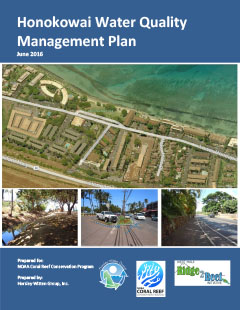-
Home
-
Data & Publications
-
Regional Portals
- About Regional Portals
- Florida
- Navassa Island
- Puerto Rico
- Flower Garden Banks
- U.S. Virgin Islands
- American Samoa
- Commonwealth of the Northern Mariana Islands
- Federated States of Micronesia
- Guam
- Main Hawaiian Islands
- Republic of the Marshall Islands
- Northwestern Hawaiian Islands
- Republic of Palau
- Pacific Remote Island Areas
-
CRCP Activities
- Glossary
Honokōwai Water Quality Management Plan

The purpose of this report is to characterize the pollutant loading and restoration potential of the 46.4-acre study area mauka of the Honokōwai Beach Park (HBP), which was identified in the Wahikuli-Honokōwai Watershed Management Plan (WHWMP) as a location for a stormwater improvement project. To conduct the study, existing information on topography, streams, stormwater infrastructure, outfall locations, etc. was compiled to develop field maps delineating drainage areas and the larger HBP watershed. A field assessment of the HBP was conducted by Horsley Witten to verify the drainage network (e.g., catch basins, pipes, manholes) and identify structural and non-structural stormwater restoration alternatives on public and private property. Primary conclusions from the field investigation include:
- A large portion of the initially estimated watershed is actually connected to the drainage system discharging into Mahinahina Stream (north of the HBP Watershed).
- Most properties in the HBP watershed have very steep driveways and parking lots with little to no stormwater infrastructure. Thus, unmitigated stormwater runoff flows into the HBP Channel without flood control or water quality treatment.
- Most of the properties have 75% impervious cover (e.g., parking, driveways, rooftops, pools, and tennis courts) or higher.
- Rooftop runoff is not typically collected in cisterns on Maui. Given the acreage of rooftops, this represents a lost opportunity to reduce runoff volume and supplement non-potable water supply via rainwater harvesting.
This study illustrates the complexity of watershed planning along an intensely-developed coastline where:
- little information is available on existing drainage infrastructure;
- the landscape is dominated by private properties with significant amounts of unmanaged impervious cover; and
- demand for publicly-owned recreational open space is high. Equally complex are the interactions between watershed runoff, coastal processes, water quality, and their effects on the nearshore ecosystems.
This study demonstrates the level of effort that can be required to fully understand the magnitude of runoff issues and illuminate the challenges of successful watershed restoration.
Citation: Horsley Witten Group, Inc. (2016). Honokōwai Water Quality Management Plan. Prepared for National Oceanic and Atmospheric Administration's Coral Reef Conservation Program. Horsley Witten Group, Inc., Sandwich, MA. 69 p.


